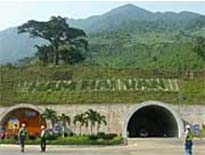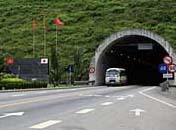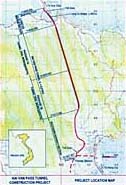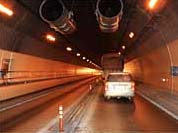- Loan Agreement Dates:
- March 26, 1997 (I)
- March 30, 1999 (II)
- March 29, 2002 (III)
- Approved Amounts:
- 5,500 million yen (I)
- 10,000 million yen (II)
- 3,359 million yen (III)
- Interest Rates (%)
- 2.3 (I)
- 1.8, 0.75 (II)
- 1.8 (III)
- Repayment/Grace Period (Years)
- 30/10 (I)
- 30/10, 40/10 (II)
- 30/10 (III)
- Executing Agency: Ministry of Transport
- Project Sites: Da Nang City - Thua Thien Hue Province
Summary
National Highway No. 1 is a north-south trunk line for people and goods transportation. Hai Van Pass is situated in the Highway, peaking at 496 meters in altitude along its 21 kilometers between central Hue and Da Nang, playing an important part in the East-West Corridor in the country’s central region. This is one of the most dangerous sections of the highway because of its narrow carriageway width and the nature of the terrain, especially, during rainy season. As it takes more than an hour for an ordinary vehicle to pass this section, the pass hinders smooth transportation on the highway as well as development in the central region. As a part of assistance to Vietnam’s Ministry of Transport, JICA has provided loan financing three times since 1996 for the Hai Van Pass on National Highway No. 1 to construct a tunnel (two lanes each direction) 6.3 kilometers in length as well as an approach roadway and bridges (including Lang Co Bridge) to ensure the safe passage of road traffic as well as to make transportation more efficient. To assist resident relocation being promoted by the Vietnamese government, funding was also allocated to building infrastructures at the location where some 72 families were to be relocated for the project.

The Hai Van Tunnel opened for traffic on June 5, 2005, shortening the travel time from over an hour to about 10 minutes, expanding the traffic network in the central area and greatly improving the distribution of goods between Hanoi and Ho Chi Minh City. Further economic development in this region is expected as East-West Corridor planning progresses.
Project Highlights
Boring the Longest Tunnel in Vietnam – 6,280 meters
Hai Van Pass, which connects Hue and Da Nang, reaches an altitude of 496 meters. With many curves and falling rocks during the rainy season, the road section over the Pass was a black spot for traffic accidents.

As roads are said to be the arteries of a nation, their construction provides an important infrastructure for the regional and national economies. Economic growth in the region is sure to occur if passage is made easier between Da Nang—the largest city in the central region—and the tourist city of Hue.
Construction began in August 2000, the project costs some 150 million dollars in expenses and involves more than 2,000 construction workers. The tunnel segment is split into two parts, the 4-kilometer southern portion, constructed by Japanese construction company Hazama, and the 2-kilometer northern portion constructed by a Vietnam-South Korea joint venture.
Overcoming a Deluge
When construction had progressed about 70 percent of the way at the end of 2002, an incident occurred in which a massive volume of water gushed up from the bedrock. The incident caused a great deal of dismay.
That was the moment when Japanese technology shined. Using their abundant construction experience, Hazama brought in a large pump and pumped the water out. As a result, water over the tunnel gradually gone.

The Fruits of International Cooperation
One of the leaders involving in guiding the project along the difficult path to success was Nguyen Ngoc Canh. He recalled the project, “The construction generally went smoothly, but we had some problems communicating with the Japanese people.”
Canh also recalled a range of other difficulties that were overcome through Japanese technological power and Vietnam’s proactive implementation of international standards. “When this work was started, we hardly knew anything, but with the JICA guidelines, we were able to solve our problems one at a time. As a result, our capacity in Vietnam to manage official development assistance and improve our technological capacity improved.”

Aiming for a Tunnel with Vietnamese Technology
The Hai Van Tunnel was completed in June 2005. The project took four years and 10 months. With this new Tunnel, the travel time shorten from more than an hour to 15 minutes.
With a force behind his words, Canh said, “Our next target is to complete a tunnel using our own construction technology. A project which is the same scale with the Hai Van Tunnel would still be too difficult for us, but in the near future, I would like to complete a project using the technology we learned from Japan.

Photography and cooperation in writing: Masato Nishigai of the Nishigai Photo Studio





scroll